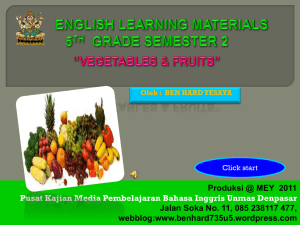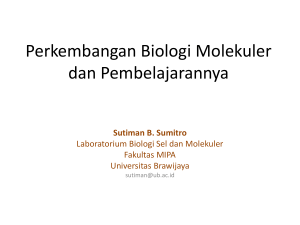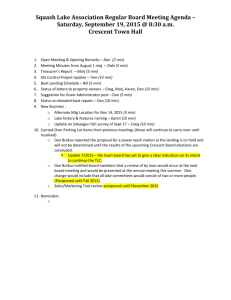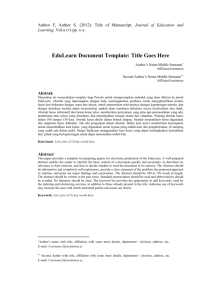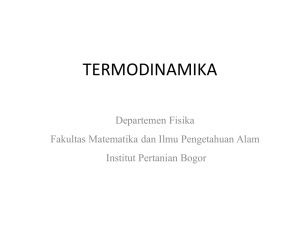Evaluasi Kawasan Lindung Berdasarkan Rencana Tata Ruang
advertisement
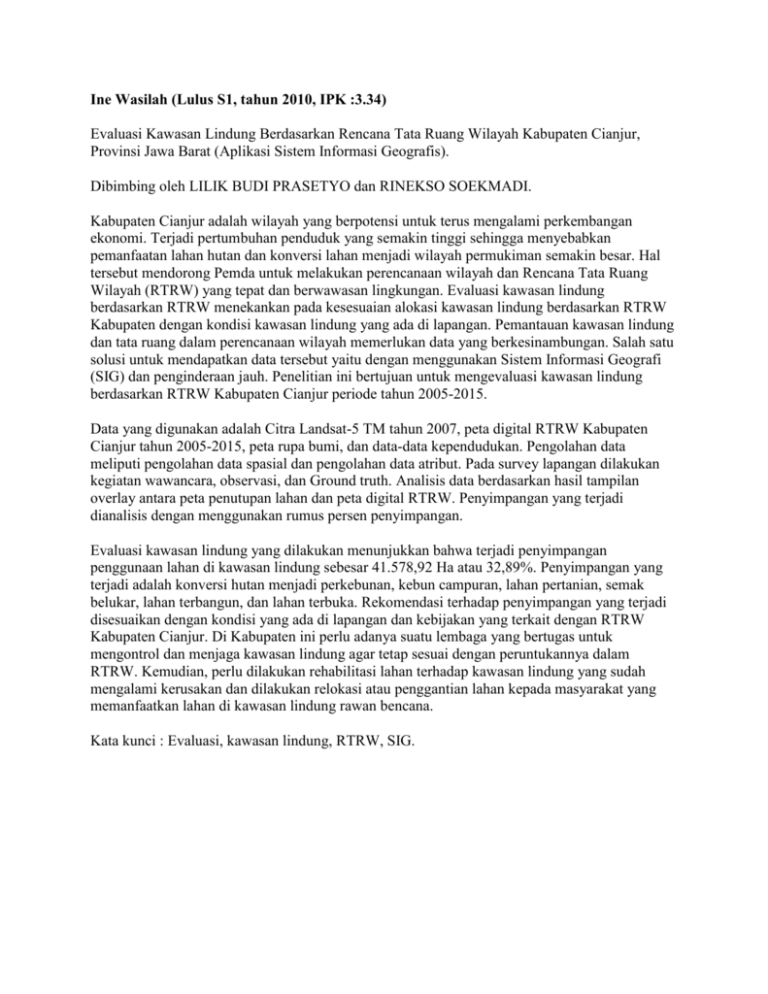
Ine Wasilah (Lulus S1, tahun 2010, IPK :3.34) Evaluasi Kawasan Lindung Berdasarkan Rencana Tata Ruang Wilayah Kabupaten Cianjur, Provinsi Jawa Barat (Aplikasi Sistem Informasi Geografis). Dibimbing oleh LILIK BUDI PRASETYO dan RINEKSO SOEKMADI. Kabupaten Cianjur adalah wilayah yang berpotensi untuk terus mengalami perkembangan ekonomi. Terjadi pertumbuhan penduduk yang semakin tinggi sehingga menyebabkan pemanfaatan lahan hutan dan konversi lahan menjadi wilayah permukiman semakin besar. Hal tersebut mendorong Pemda untuk melakukan perencanaan wilayah dan Rencana Tata Ruang Wilayah (RTRW) yang tepat dan berwawasan lingkungan. Evaluasi kawasan lindung berdasarkan RTRW menekankan pada kesesuaian alokasi kawasan lindung berdasarkan RTRW Kabupaten dengan kondisi kawasan lindung yang ada di lapangan. Pemantauan kawasan lindung dan tata ruang dalam perencanaan wilayah memerlukan data yang berkesinambungan. Salah satu solusi untuk mendapatkan data tersebut yaitu dengan menggunakan Sistem Informasi Geografi (SIG) dan penginderaan jauh. Penelitian ini bertujuan untuk mengevaluasi kawasan lindung berdasarkan RTRW Kabupaten Cianjur periode tahun 2005-2015. Data yang digunakan adalah Citra Landsat-5 TM tahun 2007, peta digital RTRW Kabupaten Cianjur tahun 2005-2015, peta rupa bumi, dan data-data kependudukan. Pengolahan data meliputi pengolahan data spasial dan pengolahan data atribut. Pada survey lapangan dilakukan kegiatan wawancara, observasi, dan Ground truth. Analisis data berdasarkan hasil tampilan overlay antara peta penutupan lahan dan peta digital RTRW. Penyimpangan yang terjadi dianalisis dengan menggunakan rumus persen penyimpangan. Evaluasi kawasan lindung yang dilakukan menunjukkan bahwa terjadi penyimpangan penggunaan lahan di kawasan lindung sebesar 41.578,92 Ha atau 32,89%. Penyimpangan yang terjadi adalah konversi hutan menjadi perkebunan, kebun campuran, lahan pertanian, semak belukar, lahan terbangun, dan lahan terbuka. Rekomendasi terhadap penyimpangan yang terjadi disesuaikan dengan kondisi yang ada di lapangan dan kebijakan yang terkait dengan RTRW Kabupaten Cianjur. Di Kabupaten ini perlu adanya suatu lembaga yang bertugas untuk mengontrol dan menjaga kawasan lindung agar tetap sesuai dengan peruntukannya dalam RTRW. Kemudian, perlu dilakukan rehabilitasi lahan terhadap kawasan lindung yang sudah mengalami kerusakan dan dilakukan relokasi atau penggantian lahan kepada masyarakat yang memanfaatkan lahan di kawasan lindung rawan bencana. Kata kunci : Evaluasi, kawasan lindung, RTRW, SIG. 5. Yohana Maria Indrawati (S1, Lulus 2010, IPK:3.42) YOHANA MARIA INDRAWATI. Pemodelan Spasial Habitat Monyet Hitam Sulawesi (Macaca nigra Desmarest, 1822). Dibimbing oleh DONES RINALDI dan LILIK BUDI PRASETYO Monyet hitam sulawesi (Macaca nigra Desmarest, 1822) memiliki daerah persebaran yang terbatas hanya di wilayah Sulawesi bagian utara dan juga di pulau Bacan, Maluku sebagai jenis introduksi. Habitat yang tersisa di Sulawesi Utara terbatas pada kawasan konservasi diantaranya adalah Cagar Alam (CA) Tangkoko, CA Duasudara, Taman Wisata Alam (TWA) Batuputih, dan TWA Batuangus di Kabupaten Bitung Sulawesi Utara. Berkaitan dengan kondisi tersebut maka penelitian habitat monyet hitam sulawesi dengan penerapan Sistem Informasi Georgafis (SIG) perlu dikembangkan untuk mendapatkan data spasial model habitat yang sesuai. Pengambilan data dilakukan di CA Tangkoko dan TWA Batuputih sedangkan untuk areal penelitian dalam analisis spasial pembuatan model dan peta kesesuaian habitat mencangkup CA Tangkoko, CA Duasudara, TWA Batuputih, dan TWA Batuangus. Pemodelan habitat monyet hitam sulawesi dilakukan dengan mengidentifikasi titik perjumpaan monyet hitam sulawesi secara spasial terhadap faktor-faktor habitat dan faktor faktor gangguan. Faktor habitat diidentifikasi melalui ketinggian, kemiringan lereng, NDVI (Normalization Difference Vegetation Index), dan jarak dari sungai. Faktor gangguan diidentifikasi melalui jarak dari jalan dan bangunan. Pembobotan untuk mendapatkan model dilakukan menggunakan metode Principal Component Analisys (PCA) dan pengkelasan dilakukan dengan metode tumpang tindih (overlay). Model kesesuaian habitat monyet hitam sulawesi adalah Y = (2,399xFkjalan) + (2,399xFksungai) + (2,399xFkNDVI) + (2,399xFktinggi) + (1,142xFkbangunan) + (0,957xFklereng). Tumpang tindih model tersebut menghasilkan tiga kelas kesesuaian habitat monyet hitam sulawesi yaitu kelas kesesuaian tinggi (5160,96 hektar), kelas kesesuaian sedang (2843,10 hektar), dan kelas kesesuaian rendah (204,39 hektar). Peta kesesuaian habitat dapat diterima dengan akurasi memprediksi habitat monyet hitam sulawesi dengan kesesuaian tinggi sebesar 76,67% dan kesesuaian sedang sebesar 20,00%. CA Tangkoko memiliki habitat dengan kesesuaian tinggi tertinggi yaitu 79,34% sedangkan CA Duasudara memiliki habitat dengan kesesuaian tinggi terendah yaitu sebesar 39,83%. TWA Batuangus memiliki persentase habitat dengan kelas kesesuaian sedang dan rendah tertinggi yaitu 40,91% dan 10,48%. Berdasarkan persentase kelas kesesuaian habitat tersebut terlihat bahwa CA Tangkoko merupakan kawasan dengan habitat yang paling sesuai untuk monyet hitam sulawesi sedangkan CA Duasudara dan TWA Batuangus merupakan kawasan dengan habitat yang kurang sesuai untuk monyet hitam sulawesi. Berdasarkan tingkat gangguan berupa degradasi habitat, Cagar Alam Duasudara memiliki tingkat gangguan terbesar sehingga kepadatan populasi monyet hitam sulawesi di kawasan tersebut lebih rendah dibandingkan kawasan lainnya. TWA Batuputih memiliki habitat dengan kesesuaian sedang yang letaknya berbatasan dengan pemukiman dan ladang penduduk padahal kawasan tersebut merupakan wilayah jelajah dua kelompok monyet hitam sulawesi yang memiliki ukuran populasi yang besar dan terhabituasi dengan manusia. Kondisi tersebut memerlukan penanganan berupa pengamanan pada habitat dengan kesesuaian tinggi, pengaturan tata batas antara kawasan CA dan TWA, serta pembinaan habitat pada habitat dengan kesesuaian sedang dan rendah terutama pada perbatasan kawasan dengan pemukiman dan ladang penduduk. 6. Mardiana Wachyuni (S1, Lulus 2010) Mardiana Wachyuni. E34050002. Identifikasi Faktor Penyebab Deforestasi Ditinjau dari Aspek Sosial dan Ekonomi (Kasus di KPH Kuningan). Dibimbing oleh LILIK BUDI PRASETYO dan SONI TRISON. Deforestasi adalah perubahan hamparan hutan menjadi bukan hutan. Deforestasi tidak hanya terjadi di hutan konservasi ataupun hutan lindung saja, tetapi juga bisa terjadi di hutan produksi. Hutan produksi yang terdapat di Pulau Jawa dikelola oleh Perum Perhutani. Menurut Ichsan (2006), pada umumnya keberadaan hutan yang dikelilingi oleh desa dengan kondisi sosial, ekonomi yang tergolong miskin. Kepemilikan lahan yang sempit, kemampuan teknologi yang masih redah, serta kelangkaan modal dan akses pelayanan yang langka membuat penduduk desa sekitar hutan sulit untuk bangkit dari belenggu kemiskinannya. Sementara itu lahan hutan belum optimal memberikan sumbangan pendapatan bagi masyarakat sekitar hutan. Penelitian ini bertujuan untuk mengetahui tingkat deforestasi (hutan alam dan tanaman) di KPH Kuningan dan mengidentifikasi faktor sosial dan ekonomi yang berhubungan dengan deforestasi di KPH Kuningan. Hasil penelitian ini diharapkan dapat menjadi informasi/masukan bagi pihak Perum Perhutani dalam perumusan kebijakan/program dalam rangka menekan laju deforestasi/kerusakan hutan. Penelitian ini dilakukan di KPH Kuningan mulai dari bulan Juni-Desember 2009.Alat yang digunakan dalam penelitian ini yaitu seperangkat komputer yang dilengkapi dengan software Arc View GIS 3.2, ERDAS Imagine 9.1, SPSS 15.0, Microsoft Office Excel 2007, Global Positioning System (GPS), tape recorder, kamera digital, kusioner (Masyarakat Desa Hutan dan Lembaga Masyarakat Desa Hutan), dan alat tulis, sedangkan bahan yang digunakan yaitu citra Landsat 7 ETM (Maret 2002) dan 5 TM (Maret 2009) path/row 121/65,peta Rupa Bumi Indonesia skala 1 : 25000, potensi desa tuhun 2006, statistik Registrasi Lembaga Masyarakat Desa Hutan KPH Kuningan sampai dengan bulan Mei 2009, dan Rekapitulasi Hasil Identifikasi Zona Kerawanan (Red/Green Zone Area) periode Juli-Desember 2008 KPH Kuningan. Penutupan lahan Kabupaten Kuningan dapat diklasifikasikan kedalam 11 tipe penutupan lahan, yaitu (1) hutan alam/sekunder, (2) hutan tanaman jati, (3) hutan tanaman pinus, (4) lahan terbangun, (5) sawah, (6) kebun campuran, (7) ladang, (8) rumput dan semak belukar, (9) badan air, (10) lahan terbuka, dan (11) tidak ada data. Selama periode tahun 2002-2009, kebun campuran merupakan tipe penutupan lahan yang memiliki wilayah paling luas di Kabupaten Kuningan. Deforestasi hampir terjadi pada semua wilayah di Kabupaten Kuningan. Dalam kurun waktu 2002-2009 terjadi deforestasi di Kabupaten Kuningan sebesar 1.630.593 ha dari total luas hutan 2.961.819 ha. Dalam pengambilan desa responden masyarakat desa hutan, desa deforestasi yang diambil adalah Desa Sukarapih dengan deforestasi sebesar -4,20 ha/tahun, sedangkan desa reforestasi yang diambil adalah Desa Segong dengan reforestasi sebesar 6,77 ha/tahun. Faktor sosial ekonomi yang berpengaruh nyata terhadap deforestasi berdasarkan hasil analisis statistik dengan menggunakan model regresi logistik yaitu pendapatan/tahun, gangguan keamanan hutan, pengetahuan mengenai adanya tebangan Perhutani, dan partisipasi dalam kegiatan Perhutani. Kata kunci: deforestasi, penutupan lahan, faktor sosial dan ekonomi. 7. Abdul Hamid Rahmat, E341020142010 Mapping of Hazard Areas and Risk Analysis of Landslide Disaster with Geographic Information System (GIS) (Case Study in Ciremai Foothills Region, Majalengka District) Landslide disaster is one of the natural disasters, than often occur in Indonesia and is generally common in mountainous regions, the rainy season and is closely related to natural conditions such as soil type, rock, rainfall, land slope and land cover.The aim of this study is to mapping hazard landslide area and to analyze the risk landslides in the Ciremai region Majalengka district. Puslittanak (2004) is using to be a model of analyzing landslide susceptibility prediction in study area, the formula is Total Score = 0,3 Frain Falls + 0,2 Fgeology + 0,2 Fland Slope + 0,2 Fland Cover + 0,1 Fsoil Types.Risk analysis was analyzed by quantitative models based on research of Alhasanah (2006) throught the overlaying property map score (infrastructure map, road map and land cover) with landslide vulnerability map. In study area, low landslide suspectibility class dominated by flat topography, the dominant rock type is Qa (Aluvium), soil type is Latosol and rainfall intensity 2500-3000 mm/year.Mdeium landslide suspectibility occur in flat to a relatively steep slope with the type soil dominated by Andosol and level of rainfall intensity is 2500-3000 mm/year.At high landslide suspectibility, dominated land cover is forest with steep topography (15-30%), rock type is dominated by Qvu and the soil type is Andosol with rainfall 3000-3500 mm/year.Very high vulnerability to landslide mostly located in forest areas with very steep slope (>45%), high rainfall intensity 3000-3500 mm/year and dominated by Qvu rock type and Andosol soil type. Based on the analysis of vulnerability map, in area study obtained low vulnerability covered area 2160,45 hectares, medium vulnerability with covered 15319,71 hectares, 21992,49 hectares of high landslide vulnerability and very high vulnerability covered 6191,91 hectares.Very high vulnerability mostly located in Argapura with 2811,78 hectares (45,41%).Based on the analysis of risk maps, the area of research has a low risk area with a wide level of 13212,36 hectares (28,93%), medium risk level covered 31507,38 hectares (69,00%), high risk level covered 806,94 hectares (1,77%) and very high risk level covered 137,88 hectares (0,30%).Areal distribution of very high risk level areas are the largest in the Maja with covered area 31,67 hectares (23,96%). 8. Rika Setiabudi Santoso Evaluation of Protection Area with Application Geographic Information System (SIG) at Pandeglang Regency, Banten. The space necessity is increasing along with the growth of population. It is become one of things which causing exploitation of natural resources and abuse of space using. Protection area is a supporting system for life, it is useful for caring the environment balance, but in fact it has destroyed and changes its function. Pandeglang is one of potential area and has problem with environment. Geographic information system (GIS) can perform the newest data and help to get decision of space policy to push the protection area management which attend its protection function to realize friendly environment development. The research carried out on September until November 2009 in Pandeglang Regency, Banten. The research purpose is to identification legal formal protection area based on President decision Number 32 on 1990 about protection area management and ministry agriculture decision Number 837 on 1980 about criteria and method arrangement protected area decision, identify the protection area gap and abuse and strategy formulate and direction policy of management legal formal protection area. The data was got in thematic map, remote sensing and direct observation. Data tabulation included spatial and attribute data tabulation with ArcView, ArcGIS and Erdas Imagine software. Data analysis was based on the results of overlay analyst and the percentage of deviation (summary) analyst between digital maps. Evaluation toward space pattern and space protection area structure. Actual protection area DFH based on Distribution of forest function (DFH) in Pandeglang Regency is Ujung Kulon National Park (TNUK), Nature Recreation Park (TWA) Carita and forest protect totally 66.465,15 Ha (23,64%). Actual protection area RTRW based on space area allocation in space area arrangement plan (RTRW) in Pandeglang Regency is TNUK and forest protected in the amount of 68.782,06 Ha (24,46%) and legal formal protection area is 173.160,13 Ha (61,58%). Gap between legal formal protection area with Actual protection area is 99.957,20 Ha (35,55%).Protection area condition all dominated by forest with different wide. Actual forest protection area DFH wide is 43.800,65 Ha (65,90%), actual protection area RTRW is 41.965,34 Ha (61,01%), legal formal protection area is 50.328,99 Ha (29,06%). Space arrangement is needed to realize movement development, but there is an abuse and inconsistency in planning step. Legal formal protection area abuse in actual protection area is 110.458,85 Ha (63,79%); legal formal protection area abuse in RTRW is 110.874,43 Ha (64,03%); actual protection area abuse DFH in actual RTRW is 8.082,16 Ha (12,16%); unsafe area from natural disaster abuse in actual protection area RTRW is 66.594,42 Ha (74,24%). Direction and strategy in protection area management in Pandeglang Regency needs some steps. In pressing legal formal protection area management by pointing the instance or institution with giving them authority and responsible to manage legal formal protection area especially in unsafe area from natural disaster and local protection area. RTRW document review is needed contrive to actual data from the instance and use similar format of data reference and consisten in space arrangement. 9. Kuntoro Bayu Aji Reptile Diversity Distribution in Several Habitats of Taman Nasional Lore Lindu. Indonesian biodiversity facing a serious challenge in terms of identification of species contained therein. The conservation of species cannot be separated from the ecosystem. Lore Lindu National Park is a representative of humid tropical forest ecosystem types with high biodiversity inside. Including the diversity of reptiles species. Diversity of reptiles species and it is distribution pattern is studied in this research. The study was conducted in June-August 2008 in Lore Lindu National Park. The research site area inside the park is in Resort Lindu and Resort Mataue. Materials used in this study is the type species of reptiles and their habitats as well as alcohol. The equipment used is standard equipment for collecting reptiles species data using visual encounter survey method. Including RBI map sheet 2114-41 and 2014-62, reptiles observation equipment, documentation equipment, GPS receivers, stationery, and computer hardware and software. Reptiles data collection based on visual encounter survey method. Habitats vegetation analysis based on quadrats transect line described by Oasting (1948). Only captured or documented reptil species that can be identified which entered into the list of species found. Reptiles species data observation using active searching reptiles specimen and glue trap. The result, 17 reptiles species can be identified from the research area. Six species distributed inside plantation habitat type, eleven species inside the transitions areas habitat type, and seven species inside the forest. Transitions areas habitat type form the highest reptiles species richness. Shown by species list and Margalef’s index. But there inside Eutropis multifasciatus dominating significantly. Forest habitat type is the highest reptiles species diversity value shown by Shannon-Wiener Index. Although the number of reptiles species distributed there in less than transition areas, the reptiles species distributed more evenly. 10. Afiefah Bainnaura The Application of ALOS PALSAR Image 50 m and 12,5 m Resolution for Land Cover Identification (Case Site: Bogor and Sukabumi District) The Phases Array type L-band Synthetic Apeeture Radar (PALSAR) sensor wquiped in ALOS Satellite is an active microwave sensors. ALOS PALSAR can observe all day and night and its operation is not affected by weather condition. Today, the use ALOS PALSAR image for mapping land cover and land use is limited. Therefore, it is necessary further review of the ALOS PALSAR image ability in identifying land cover. He research objective are to evaluate ALOS PALSAR image 50 m resolution ability and interpretation capacity of ALOS PALSAR image 12,5 m resolution analysis for identifying land cover. The study site is located in Bogor and Sukabumi District, West Java Province. The method of this research are consist of collection data, pre-processing image, field observation, analysis of field observations with discriminant analysis and visual analysis of ALOS PALSAR image at 50 m resolution, and interpretation capacity analysis of ALOS PALSAR image at 12,5 m resolution. The interpretation of ALOS PALSAR image 50 m resolution by discriminant analysis produce 6 land cover classes with 0,509 proportion correct, namely water body, agriculture, dry land agriculture, settlement, field and trees, whereas by visual produce 12 land cover classes namely water body, airport, dry land forest, mixed gardens, rubber plantation, oil palm plantation, tea plantation dry land agriculture, settlement, field, shrub and bare land. Identification of land cover visually need additional information such as road network, and altitude. The most easily object to be interpreted or recognized are water body, airport, rubber plantation and settlement. The capability interpretation of ALOS PALSAR image 12,5 m resolution compare to ALOS PALSAR image 50 m resolution was only limited to sharpen boundary of objects and therefore its application will increase level of confident in identifying land cover. 11. Arif Prasetyo Carbon Stock Changes Assessment in Tambling Wildlife Nature Conservation Bukit Barisan Selatan National Park. Global warming effect can be mitigated in two ways, namely carbon loss reduction or emission and increasing carbon storage within vegetation. Forest can absorb CO2 trough photosynthesis process and sink them in biomass. Tambling Wildlife Nature Conservation (TWNC) as a part of Bukit Barisan Selatan National Park (BBSNP) have been facing land cover change due to encroachment. The study aimed to measure carbon stocks in various land cover and to compare carbon stocks for the whole are of TWNC TNBBS in 2000-2009. Carbon stocks measurement was conducted in TWNC TNBBS during August 8th to October 8th 2009, 50 plots were sampled including nature forest, secondary forest, agroforestry, shrub, Imperata cylindrica , and grassland by purposive sampling method. Soil carbon was not measured in this study. Nature forest has the highest carbon stocks by 178,44 MgC.ha-1, and grassland be a poorest carbon stocks (1,47 MgC.ha-1). During the time between 2000 to 2009, primary forest carbon stock decrease in amount of 457,792.52 Mg along with the decrease in land cover of this forest type. As many as 24.4% of natural forests in 2000 turned into the others type of land use such as a secondary forest of 21.63%, for shrubs 1.61% and 0.06% for agroforestry in 2009. Totally, TWNC TNBBS has loss its carbon stocks as many as 279422 Mg, it’s mean the annual average carbon stocks contained in the TWNC TNBBS area decreased by around 27,942.2 Mg (0.72%) per year. Its mean, 1,024,547 Mg CO2 or 102,454.7 Mg CO2 every year was lose from TWNC TNBBS area. 13. Anjeliya Eka Puminda Land Cover Identification Using ALOS PALSAR Image 50 m and 12,5 m Resolution (Case Study In D.I. Yogyakarta and Central Java Province) Indonesia has been using optic image for land cover monitoring system. Thre are many problems in its application, especially for Indonesia which has two seasons. During rainy season data acquisition are interfered by cloud, but during dry season in some parts are influenced by smoke or haze. It makes the data under the cloud or smoke cover unknown. Nowadays, a land cover monitoring system has been developed which has clear image without smoke and clouds cover. That is radar PALSAR image which comes from ALOS satellite. The ALOS PALSAR sensor transmits the energy pass the clouds and smoke. Today, the implementation of ALOS PALSAR is still limited. Therefore, it needs further research of ALOS PALSAR image classification so taht can interpreted easily. The aims of this research are (a) to find technique to interpret ALOS PALSAR image 50 m resolution visually, (b) analysis the capability visual interpretation of ALOS PALSAR image 12,5 m resolution. The methods in this research consist of image processing, ground observation and data processing. The result of discriminant analysis of ALOS PALSAR image can identify 7 land covers, namelly water body, plantation forest, eucalyptus plantation, private plantation forest, dry land agriculture, building area and rice field with 50,5% correct. Those land covers can not be regrouped further because some reasons (a) the digital number is significantly different, (b) different visualizations in the image, (c) the ecology conditions in the field. Visual interpretation by using 7 elements of interpretation are color, shape, size, texture, pattern, site and assosiation gives the result that ALOS PALSAR image can identify 8 land covers, namelly water body, pine plantation forest, teak plantation forest, mix garden, dry land agriculture, building area, rice field and coconut garden. ALOS PALSAR image 12,5 m resolution can provide more detail boundaries of the objects that ALOS PALSAR image 50 m resolution in visual interpretation process, but there is no any additional objects can be identified. 13. Mohammad Farikhin Yanuarefa Effect of Transition Area on Herpetofauna Distributions in Tambling Wildlife Nature Conservation Area Bukit Barisan Selatan National Park, Lampung Province. Edge effect is tendency of differences in species composition or abundance of the transition area and core area. Tambling Wildlife Nature Conservation Area (TWNC) is part Bukit Barisan Selatan National park. TWNC area consists of various types of habitats which are expected to affect composition, diversity and distribution of herpetofauna in the area. Research was carried out to determine differences in species composition, species diversity and distribution between the transition area and core area. Research was carried out in Tambling Wildlife Nature Conservation and Laboratory of Environmental Analysis and Modelling of Spatial Faculty of Forestry IPB, in August 2009-January 2010. Amphibian and reptile were collected using Visual Encounter Survey (VES) with transect design method in coastal forests, lowland forests, gardens, transition area between the coastal forest and lowland forest as well as the transition area between the garden and lowland forest. Total amphibians found are 19 species. All species of amphibians are found along transects. There were 33 species of reptiles, consisting of 18 species found in transects and 15 species outside transects. Herpetofauna species composition differs among habitat types, as well as between transition area and core area. In core area, lowland forests have the highest number of amphibian species (14 species), followed by garden (8 species) and coastal forest (3 species). Lowland forests and coastal forest have the same number of species (10 species) of reptiles and garden (8 species). Number of species in transition area is 5 species of amphibians and 2 species of reptiles between coastal forest and lowland forest and 2 species of amphibians and 2 species of reptiles between garden and lowland forests. Differences in habitat type did not influence the value of species diversity index except for number of individual. More amphibians are found in low land forest area whereas reptile is found more on coastal forest. Spatial distribution of amphibian tends to congregate in lowland forest area consisting more micro habitats, close to fresh water source and protected from dessication. Reptile tends to distributed randomly due to its higher mobility that amphibian. Lower number of herpetofauna found at the transition area compared to core area, show that edge effects is negatively impacted the distribution of herpetofauna especially in fragmented area. 14. Pande Made Wisnu Temaja Developing Urban Forest Based on Surface Temperature Distribution of Denpasar City Denpasar is capital city of Bali Province. Denpasar city has been developing due to its population growth and development in many sectors. This condition resulted in environmental problem especially surface temperature increase which creates uncomfortable condition. One of important component to create comfortable environmental in the city is urban forest. Appropriate planning of Open Green Space is needed to lowering surface temperature. The aims of this study are as follows: (1) identify surface temperature distribution of various land covers in Denpasar, (2) identify surface temperature which is predicted by converting band 6 Landsat 7 ETM, (3) determine the alternative of urban forest type based on surface temperature distribution which appropriate to Denpasar spatial planning. This study was conducted in Denpasar. Materials that were used in this study consisted of image Landsat 7 ETM (Path 116 Row 066) taken on 15th October 2009, and administrative map of Denpasar. Data were processed using ArcGIS 9.3 and ERDAS Imagine 9.1 such as layer stack, geometric correction, subset image, image classification and accuracy test. Band 6 was used to determine surface temperature distribution. Denpasar was dominated by built up areas (49,45%), out of 12.891.6 ha of its total area. Based on band 6 estimation, the highest surface temperature was 33-34OC in barren land of South Denpasar Subdistrict (Sesetan), meanwhile the lowest surface temperature was 17,9OC in mangrove area in South Denpasar District. The result showed that the highest surface temperature was 30OC in the form of barren land, meanwhile the lowest was 27,89OC in the form of dense vegetation space. Green Space in Denpasar in 2009 was 43,11% out of total area. Based on surface temperature distribution, there are some appropriate alternatives to develop urban forest. Urban forest type green belt, yard-park, green roof are appropriate in Developing area I that consists of security, industrial and recreational characteristics. Urban forest of park type is appropriate in Development area II, which has function as protection. Yardipark and green belt are appropriate in developing area III that consists of sttlements and security. Garden city urban forest is appropriate in Developing area IV that consists of recreational characteristics. Urban forest type green belt along the arterial roads (solid line of vehicles) are appropriate in Developing area V that consists of security and recreational characteristics. 15. Muis Fajar Developing The Green space on The Surface Temperature Distribution and Temperature Humidity Index of Palembang City Palembang is the provincial capital of South Sumatra. The Municipality are experiencing increase of population and fast development in many sectors. This resulted in the increase of built up areas and reduce green open space (green space). The condition lead to micro-climate changes, such as increasing air temperature and decreasing humidity that worsen the comfort ability of living. The study aims to: (1) identify the spatial distribution of surface temperature in some types of land cover, NDVI (Normalized Difference Vegetation Index) and its relation to the green open spaces, (2) Mapping of Temperature Humidity Indeh (THI) or comfort index in the region of Palembang, and (3) Development of Grren space based on the distribution of surface temperature, air humidity, THI and urban planning. The study was conducted in the city of Palembang. Materials used in this reseacrh are a Landsat 7 ETM (Path 124 Row 062) dated May 10, 2001 and August 23, 2010 and the administrative boundary map of Palembang. Processing of Landsat 7 ETM image data using a set of computer equipped with software ArcGIS 9.3 and Erdas Imagine 9.1, which includes the layer stack, geometric correction, cropping the image, image classification, and test accuracy. Estimation of surface temperature was conducted by using band 6. Furthermore, estimation results are used to estimate temperature and air humidity comfort index (THI) in the city of Palembang. In addition, the determination of vegetation land cover was also done using NDVI. NDVI values were used to determine the relationship between surface temperature and land cover. Palembang usrfece temperature ranges from 27OC to 39OC. Surfece temperature on the green space ranges from 28OC to 32OC, while the surface temperature in the build up area more than 33OC. There was an increase in surface temperature from 2001 until 2010. The changes were assosiated with reduction of green space area. RTH can be predicted with NDVI values. NDVI values greater than 0 and less than 1 was vegetation. Surface temperature has the opposite relationship with NDVI. The greater surface temperature the lower the NDVI value and vice versa. Palembang City was entirely classified into incomfortable class in 2001 and 2010, since the city located in THI value over 26. Development of green space in the city of Palembang was divided into three type of activities, namely, at housing areas, suburbs and downtown areas. Development of green space at settlements in the form of green yard, and its surface temperature ranges from 30OC – 34OC, humidity 60% – 70% and average THI ranged 27 – 28. In the suburbs, can be developed green space in the form of city parks and urban forest, the surface temperature of 29OC – 34OC, humidity 60% – 80%, and THI averaging around 26 – 27. In the downtown area can be developed in the form of roof garden green space and green be, the surface temperature above 33OC, humidity 40% – 60% and the average ranged THI >31.




